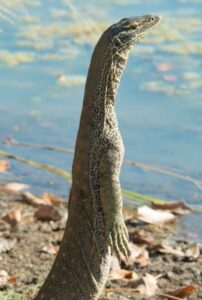Punjab Wildlife & Parks Department
MONITOR LIZARD
Punjab Wildlife & Parks Department
MONITOR LIZARD

Common Name:
Monitor Lizard
Scientific Name:
Varanus
Conservation status:
Not Endangered
Habitat in Punjab:
Forests, grasslands, and agricultural areas.
Biodiversity & Ecosystem Impact:
Monitor Lizards play a role in controlling pest populations and contribute to the ecological balance.
Unveiling the Monitor Lizard: Ancient Reptiles Roaming Modern Habitats
The Monitor Lizard, an ancient reptilian lineage, emerges as a remarkable presence in diverse habitats across the globe. Known for their imposing size and prehistoric appearance, these lizards exhibit keen intelligence and fascinating behaviors. Equipped with sharp claws and keen senses, they are formidable predators, preying on small mammals, insects, and even birds. Some species, like the Komodo Dragon, have earned a reputation as apex predators. Monitor Lizards play vital ecological roles as scavengers, seed dispersers, and predators of pests. Their ability to thrive in various environments and adapt to changing conditions showcases their resilience. Studying and conserving these remarkable creatures helps us gain insights into the intricate web of ecosystems they inhabit
Unveiling the Monitor Lizard: Ancient Reptiles Roaming Modern Habitats
The Monitor Lizard, an ancient reptilian lineage, emerges as a remarkable presence in diverse habitats across the globe. Known for their imposing size and prehistoric appearance, these lizards exhibit keen intelligence and fascinating behaviors. Equipped with sharp claws and keen senses, they are formidable predators, preying on small mammals, insects, and even birds. Some species, like the Komodo Dragon, have earned a reputation as apex predators. Monitor Lizards play vital ecological roles as scavengers, seed dispersers, and predators of pests. Their ability to thrive in various environments and adapt to changing conditions showcases their resilience. Studying and conserving these remarkable creatures helps us gain insights into the intricate web of ecosystems they inhabit

Contact Information
Location: 2 Sanda Road, Lahore.
Phone: +92 (42) 992 12367
Email: info@pwl.gov.pk
Openning hours: 9:00 AM - 5:00 PM